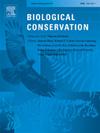The future of utilising semiochemical pest control methods to manage the destructive crown-of-thorns starfish outbreaks on coral reefs
IF 4.9
1区 环境科学与生态学
Q1 BIODIVERSITY CONSERVATION
引用次数: 0
Abstract
The Crown-of-Thorns Starfish (Acanthaster cf. solaris; CoTS) is arguably the most destructive non-human animal to coral reefs, significantly impeding coral survival in the face of the foremost effects of climate change and coral bleaching. Controlling the unprecedented number of CoTS outbreaks and damage on reef systems is vital for the survival of the reef ecosystem. The emergent strategy of using semiochemicals in terrestrial pest control management, due to their environmentally friendly nature, has generated interest in their application to control populations of this destructive species. However, there have been only a limited number of studies on promising semiochemical applications within aquatic systems. This Perspectives Review provides a much-needed outlook of CoTS chemosensory and semiochemical repertoire, how we might hypothetically utilise semiochemicals with regard to modifying CoTS behaviours and discusses future research directions and the scope for innovative semiochemical technologies with the aim of sustainably controlling CoTS populations, thereby mitigating their devastating outbreaks and destruction of coral reef systems.
求助全文
约1分钟内获得全文
求助全文
来源期刊

Biological Conservation
环境科学-环境科学
CiteScore
10.20
自引率
3.40%
发文量
295
审稿时长
61 days
期刊介绍:
Biological Conservation is an international leading journal in the discipline of conservation biology. The journal publishes articles spanning a diverse range of fields that contribute to the biological, sociological, and economic dimensions of conservation and natural resource management. The primary aim of Biological Conservation is the publication of high-quality papers that advance the science and practice of conservation, or which demonstrate the application of conservation principles for natural resource management and policy. Therefore it will be of interest to a broad international readership.
 求助内容:
求助内容: 应助结果提醒方式:
应助结果提醒方式:


